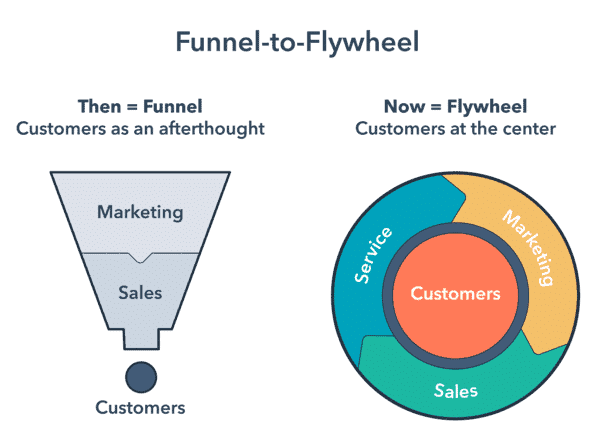How to Build a B2B Customer Journey
Podcast: Play in new window | Download
Subscribe Today RSS
Let's take a look at how to build a B2B customer journey from awareness to purchase. Understanding this process is the key to building successful relationships.
Subscribe to our weekly live stream on Facebook, or take it on the go with a podcast on your choice of platforms. Keep up-to-date on news, trends, and tips in the world of digital marketing and join in on the conversation.
There's no one-size-fits-all answer for how to find success in B2B marketing. However, one thing that always matters is the customer experience - which has been largely ignored in the B2B space compared to B2C marketing.
Today's consumers have more control over how they interact with your brand. There are more touchpoints, more complexities, and so many more options than ever before.
We consume information differently; we're plugged in, busier, and have high expectations - and we don't want to be sold to before we're ready to buy.
That's why the customer journey is so crucial to understanding how to build your marketing strategy around the customer experience.
What's New?
2020 has started with a weird bang. Businesses have been left wondering how to move forward, and amidst all these sudden changes come new trends and tactics to align with the culture of the times.
Our busy bees have been scouring the internet for the buzz on B2B customer journeys in 2020. We've found some gems to share with you:
- How to Own the B2B Customer Journey in 2020 - A good read from VentureHarbour with insights on lead generation, lead nurturing, and B2B customer retention in 2020.
- How to Adapt B2B Digital Marketing to the Buyer Journey in 2020 - An interesting article with some eye-opening statistics on understanding the B2B customer journey. Learn how to apply that knowledge to your digital marketing campaigns for success in any economic climate.
- Perfecting your B2B CX strategy in 2020 - 57% of B2B marketers listed ‘understanding the target audience’ as their most pressing challenge. This article offers 3 ways B2B marketers can build better customer experiences in 2020.
- The B2B Customer Journey; High-Ticket Lead Generation Strategy in 2020 - Settle into a comfy chair for this one - it's an extensive overview of the B2B customer journey in 2020. Covered in 6 stages - from finding leads to building trust, to closing the sale.
What's Working?
Compared to B2C, the B2B customer experience tends to fall to the wayside. Perhaps this is because marketers are trying to market to a brand, rather than an actual human being. This leaves their efforts ignored or passed over by the people behind the brand they're trying to reach.
Things are changing in 2020, as the customer experience rises to the forefront of B2B marketing campaigns. Competition is fierce and reaching your target audience requires humanizing strategies to build lasting relationships.
The best way to understand your customer is to understand the stages of the customer journey, so let's take a look at that.
Below is a chart that details the activation funnel of a B2B LinkedIn campaign with lead score tracking to segment your leads.

As you can see from the illustration above, it's incredibly useful to segment your audience. This filtration system allows for more qualified leads, and that, of course, leads to more sales activations.
By applying a lead score at each stage, you're able to see what is catching the audience's attention, and where you're losing them. You can take this data and apply it to the next campaign or the next stage.
The result is better, more qualified leads - and just as importantly, less time spent trying to nurture cold, disinterested leads that go nowhere.
Most importantly, it allows the customer to work through their buying journey and come to their buying decision after earning their trust and giving them confidence in their purchase.

Flywheel marketing is the new way to go, with the customer at the center of the process.
Too often, the lead's contact information is sent to the sales team on the first point of contact and generally ends with no answer and a lost sale.
Your B2B lead nurturing strategy should look something like this:
- Lead qualification - it's important to choose only the leads that are worth it so that you're not wasting resources on leads that aren't invested.
- Lead scoring - allows you to prioritize and focus on the most valuable leads. The scores will change as you progress through the customer journey.
- Lead segmentation - create groups based on shared interests so that you can target them with relevant ads.
- List mapping - assign your segmented lists to specific stages of the customer journey so you can put together campaigns to help move the prospect onto the next stages of the buying process.
- Campaign delivery - choose the channels and targeting that will be most effective in delivering your campaign at the right stages of the customer journey.
So, let's break down the customer journey by taking a look at a simplified, linear example of how the buying process unfolds:

The interesting thing to note here is that more than half of the customer journey shown above happens before the buyer even starts making contact with prospective companies.
It's also important to remember that a customer buying journey is almost never actually this linear.
However, this can help B2B marketers understand the process more clearly and adjust their communication to fit into the right place in the buyer's journey. You don't want to push away potential leads with aggressive sales pitches before they're ready to make a decision.
A solid understanding of the customer journey can make marketing budgets much more effective, saving your company both time and money.
We've compiled a list of articles that further delve into different methods and approaches to the B2B customer journey and how to improve overall customer experience to help build and maintain relationships.

- How to Create an Effective Customer Journey Map [Examples + Template] - An excellent resource that walks you through the steps of how to build a customer journey map.
- 14 Visualizations Mapping The B2B Buyer Journey - This article takes you through the basics of a B2B customer journey, with a variety of visual examples.
- The new B2B customer journey: Winning the moments that matter - A quick read on the importance of leveraging data and analytic insights, considering the B2B customer's entire buying journey, and the necessity for clear and connected internal communication across all teams.
- B2B Customer Journey Mapping — Start with these 5 steps - Another easy read that asks 5 important questions to get you started in the right direction with your B2B customer journey map.
- Building the Best B2B Customer Experience - A thorough and insightful exploration of the customer experience and how to tie it into the B2B customer journey effectively.
- 5 Tactics for Creating Better B2B Customer Experiences [and more sales] - A short but excellent read with some unique insights on how to improve B2B customer experiences, such as serving instead of selling during the buying process, connecting offline and online, and the importance of thought leadership.
Finally, here is an incredibly handy PDF report from Hubspot with tons of enlightening stats on B2B marketing in 2019:
![]()

